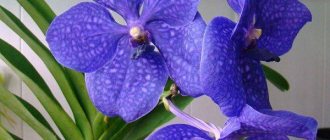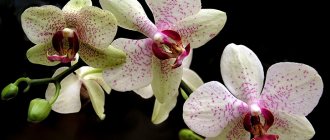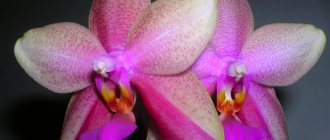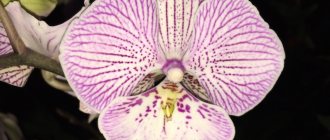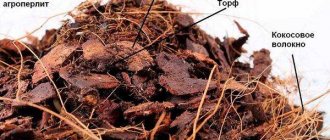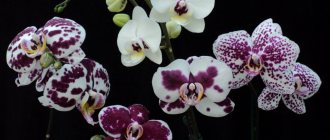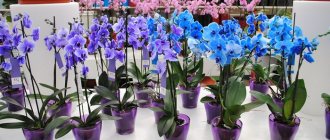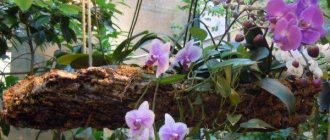Phalaenopsis stuartiana is often called the sibling of f. Schiller for the amazing resemblance and origin.
However, it differs from its sibling not only in the size and color of the flowers, but also in many other vegetative characteristics. It is easy to cultivate and blooms easily , which attracts the attention of collectors and orchid lovers.
F. Pleasant or Amabilis (Phalaenopsis Amabilis)
Growth.
Northern Australia, Indonesia, Papua New Guinea, the Philippines and some islands of the Malay Archipelago.
Biological description.
Stem with 4-5 double-rowed fleshy, shiny leaves of an elongated elliptical shape. The upper side of the leaf blade is dark green, and the lower side is purple. In nature, during a long dry period, leaves sometimes fall off.
In nature, the leaves can reach 50 cm in length. In cultivation, the leaves are smaller - from 15 to 30 cm with a width of 5-10 cm.
F. Amabilis is one of the largest-flowered natural species of the genus: flowers are from 6 to 10 cm in diameter. The peduncle is inclined, up to 80 cm long. The inflorescence is racemose, multi-flowered, up to 50 cm long.
The flowers are 7-10 cm in diameter, and in some forms they are fragrant. The sepals and petals are milky white, the lip is more or less marked with yellow or red.
Flowering in November - February. Flowering duration is 3-4 months.
Miracle of nature - black orchid
People are always attracted to things that cannot be explained.
So, there is still debate about how the black phalaenopsis appeared, who discovered it, whether it was created by nature or is it the work of breeders. It is worth saying right away that in nature there is no pigment that can color flower petals black. It is always deep blue, burgundy or purple, so deep that the human eye perceives this color as black.
Some scientists believe that black orchids were bred by scientists at the University of California, but again, these are just guesses, which cannot yet be confirmed or refuted.
This is interesting! There is a legend that the first black orchid was stolen by a botanist researcher from a tribe in South America, for which he was subjected to severe torture. However, this fact has not been documented in any way, so it remains a beautiful myth.
F. Ambonsky (Phalaenopsis amboinensis)
Growth.
Ambon, Sulawesi, Papua New Guinea and Indonesia.
Description history.
It was described in 1911 from specimens collected in the Moluccas.
Biological description.
There are 3-4 leaves in nature, 4-6 in culture. The leaves are elliptical in shape, 14-25 cm long, up to 10 cm wide.
Peduncle up to 45 cm, sometimes the orchid produces 2-3 peduncles. “Revolving” type of flowering , when one flower fades, the peduncle lengthens somewhat and a new bud appears.
All flower segments are cream, yellow or yellow-greenish, sometimes tinted orange, with brown-red transverse strokes. Flower diameter up to 6.5 cm.
Many clones have a pleasant aroma.
Sepals are elliptical in shape, with curved tips. Petals of similar shape, somewhat shorter. The lip is triple, about 2.2 cm long, the lateral parts are straight, yellow, the front part is white-green, elliptical-oval.
It can bloom at any time of the year, more abundantly in summer.
Features of flowering
In nature, flowering specimens can be found at any time of the year. In culture, this can only be achieved if constant conditions are created throughout the year, which is not always possible.
Most often, Stewart's phalaenopsis blooms in December - March. It is believed that a unique stimulus for flowering is a short period of low temperatures in the autumn, when the central heating batteries have not yet been started, but it is already colder outside and in the houses.
The buds grow and bloom almost simultaneously. Flowering can last up to 30 days.
Stewart's orchid in bloom.
F. deer-horned (Phalaenopsis Cornu-Cervi)
Growth.
Burma, India (Northeast), Nicobar Islands, Indonesia (Sumatra, Java, Kalimantan), Laos, Malaysia (Sabah, Sarawak), Philippines (Palawan), Thailand, Vietnam.
Biological description.
The stem is up to 5 cm long, hidden by the bases of 4-6 leaves. The leaves are green, up to 22 cm long and about 3-4 cm wide, light green in color.
The peduncle is long-lived, flattened, decorated on the sides with protruding bracts, 20-45 cm long, light green in color, slightly widens at the end and resembles the shape of a horn. Bears up to 12 flowers.
The flowers are 2.5-4 cm in diameter, fragrant, dense, yellow-green with red-brown transverse stripes. The variability of flower color throughout the range is very significant.
Flowering season May-August.
How to water phalaenopsis
The orchid does not require too frequent or abundant watering. It is enough to water the flower several times a week.
Watering methods:
- Water is poured into the flower tray.
- The pot with the orchid is immersed in water at room temperature for about one hour until the substrate is properly saturated.
- Using a watering can, dust and dirt are removed from the leaves.
The peculiarity of orchids is that their root system is visible. By the roots you can determine whether the phalaenopsis needs watering or not. Dried roots have a silver color, and roots that have been watered too often become brownish-brown. If you water your flower correctly, its root system will have a rich green color.
F. Konsky (Phalaenopsis Equestris)
Growth.
Philippines, Taiwan, Borneo. On tree trunks and branches in tropical rainforests at altitudes up to 300 meters above sea level.
Description history.
First described by Schauer in 1843 under the name Stauroglottis equestris. The plants were brought from the island of Luzon and belonged to Mr. Meyen.
In 1848, John Lindley re-described Phal on plants from the collection of Thomas Lobb, a worker. equestris, giving them the name Phalaenopsis rosea. In 1949 Phal. equestris got its real name.
Biological description.
Miniature monopodial epiphyte. The stem is shortened, completely hidden by the bases of the leaves. The roots are fleshy and smooth.
The leaves are dark green, oval or oblong, 10-20 cm long, 5-6 cm wide.
The peduncle appears in the axil of the lower leaves, up to 30 cm long, multi-flowered, racemose or paniculate. Continues growth after flowering begins. Easily forms “babies”.
Flowers are 1.5-3.5 cm in diameter, from white-pink to lilac. Flower color varies greatly.
There are two flowering peaks - spring and autumn, but can bloom at any time of the year.
Step-by-step instructions for transplantation
A healthy plant does not need replanting at all. It is necessary to place the pot with the phalaenopsis orchid in a basin filled with water for 30-40 minutes, covering the entire surface of the pot with a net so that pieces of bark do not float away. This is done in order to make sure whether the plant has parasites and pests.
If the substrate has become unusable, then the plant should be replanted 2-3 times a year. After a certain period of time, the substrate begins to smell acidic and becomes brittle.
Usually, phalaenopsis transplantation begins after flowering. The Phalaenopsis orchid is a feature of the growth and development of Phalaenopsis. This orchid needs a good, fresh and clean substrate in order for the phalaenopsis to grow and develop.
F. Gigantea (Phalaenopsis Gigantea)
Growth.
Borneo.
It grows high in the canopy of tropical forests at altitudes from 0 to 400 meters above sea level.
Description history.
Phalaenopsis giant was first discovered in 1897 by the botanist Nyvenhuis.
Having identified the plant as Phalaenopsis amabilis, Nyvenhuis took it to the botanical garden of the city of Buitensorg (new name Bogor).
The plant bloomed only in 1909 and was described by the director of the botanical garden, J. Smith. Shortly after the description, the only specimen of Phal. gigantea died.
Only in 1937, during the construction of a road, a second specimen of a giant phalaenopsis with leaves 90 cm long and 40 cm wide was discovered.
Phalaenopsis got its name because of its huge leaves, exceeding 60 cm in length. It is the largest representative of the Phalaenopsis genus.
Biological description.
The stem is shortened, completely hidden by the bases of the leaves. The roots are fleshy and smooth. The leaves are very wide, drooping, leathery, shiny on both sides, rounded, up to 1 meter long, up to 40 cm wide. The total number of leaves is from 2 to 7.
The peduncle is hanging, curved, sometimes branching, thin, can exceed 40 cm in length, bears 10-30 flowers.
The flowers are fleshy, 3.75-7 cm in diameter, with a faint citrus aroma, round in shape, with equal petals and sepals, cream to yellow and greenish-yellow in color, mottled with raised reddish-brown spots or streaks. Flowers have many variations in color details.
Characteristic
Phalaenopsis yellow is a long-blooming flower with a pleasant smell, honey-colored yellow. Its broad leaves do not require much sunlight.
Like other types of orchids, Phalaenopsis is a small plant with a long peduncle reaching up to half a meter in length.
The name of this plant was given by botanist Karl Blume, who noticed the similarity of the flower with butterflies (Phalaenopsis means butterfly, moth). Phalaenopsis is native to the tropics of Southeast Asia. The main feature of this orchid is that it blooms at any time of the year. Flowering occurs several times a year and lasts up to two months. During this time, about 60 flowers appear on the peduncle.
F. Hieroglyphic (Phalaenopsis Hieroglyphica)
Growth.
Islands of Palawan, Luzon, Mindanao and Polillo (Philippines).
Description history.
Introduced into cultivation in Europe in 1887 by Dr. Lowe, to whom Dr. Boxall sent several specimens of plants as a gift. The taxonomy of this species was finally determined in 1969.
It got its name due to the similarity of the pattern on the petals with hieroglyphs.
Biological description.
The trunk is shortened, completely covered with the bases of 2-8 leaves.
The leaves are green, shiny, up to 25-30 cm long, 5-9 cm wide.
Peduncle up to 30 cm long, 3-8 flowered, can branch. Undamaged flower stalks can bloom again.
The flowers open almost simultaneously, 3-4 on each branch of the peduncle. They do not fade for about a month. The flowers are dense, waxy, creamy white with numerous lemon-yellow dots or streaks forming a complex pattern, 5-8 cm in diameter. They have a pleasant aroma. Different clones have different odor intensities.
In nature it blooms in summer and autumn. Peduncles easily form babies. The tepals do not fall off after pollination, change color to green and begin to participate in photosynthesis.
Prevention
Basic care for this species includes a number of preventive measures that help maintain its health and decorativeness:
- washing the leaves and stems with soapy water once a month;
- avoiding drafts and maintaining a stable temperature regime;
- applying fertilizers strictly according to the schedule and at the above dosage;
- ensuring good lighting throughout the year;
- trimming flower stalks, yellowed and dried leaves;
- regular inspection for damage by diseases and parasites, as well as timely treatment with appropriate medications.
F. Lueddemanniana (Phalaenopsis Lueddemanniana)
Growth.
Philippines.
Epiphyte on branches and trunks of trees in tropical rainforests at altitudes from 0 to 100 meters above sea level.
Description history.
Named in honor of the French breeder F. Luddeman, who obtained the first flowering of this species in cultivation in 1865.
It was first introduced into cultivation by the horticultural farm Lowe and Co. in 1864, whose owner, E. Clapton, mistook the plant for Phalaenopsis equestris.
Biological description.
Monopodial epiphyte of medium size. The stem is shortened, completely hidden by leaves.
The root system is well developed, the roots are smooth, long, branching.
Leaves 5-8. The leaves are oval, oblong, paired, hard, 10–25 cm long, 5–10 cm wide.
Peduncle up to 35 cm long, appears from the base of the stem, drooping, bears 2-7 flowers at a time.
The flowers are 4.5-6 cm in diameter, have a pleasant strong aroma, are waxy, white in color with beautiful transverse violet-purple or chestnut lines at the bottom, and with brown tips. The lip is white with a purple coating and bright yellow markings.
The flowers are highly variable in the details of color and shape of individual parts. They open alternately over a long period of time, each flower lasts 25-30 days.
Flowering season: from spring to early autumn.
Links[ | ]
- Stewart's Phalaenopsis
species sketch on the Internet Orchid Species Photo Encyclopedia website - Phalaenopsis Stewart
, photographs of the species and primary hybrids (French) - Stewart's Phalaenopsis
species sketch on the Especes de Phalaenopsis website (English) - Stewart's Phalaenopsis
on the Electronic Plant Information Center of Royal Botanic Gardens, Kew website - Stewart's Phalaenopsis
at Tropicos.org. Missouri Botanical Garden. (English)
F. Parishii (Phalaenopsis Parishii)
Growth.
Eastern Himalayas - Myanmar, Assam India, Thailand and Vietnam.
Description history.
Discovered in Myanmar in 1864 by Reverend Father Samuel Parish, who served as rector of the local church and was an avid orchid lover.
Parish sent the found specimens to Messer Law's company at Kew Botanical Gardens. In 1865, a description of the plant compiled by Heinrich Gustav Reichenbach appeared in the Botanical Newspaper.
Biological description.
Miniature monopodial deciduous epiphyte. The root system is well developed, the roots are flat, smooth, branching. The stem is short, completely covered with leaves. There are 1-3 leaves, they are succulent, paired, dark green, elongated oval, 5-17 cm long, about 5 cm wide.
The peduncle is short, usually does not exceed the length of the leaves, erect or oblique, flat, 5-14 cm long, appears from the base of the stem, bears 4-10 flowers. There may be several flower stalks.
The flowers are fragrant (fruity-candy smell during the day), long-lived, about 2 cm in diameter, bloom simultaneously, last 15-20 days. The flowers are milky white with a very wide lip.
The middle lobe of the lip is purple or purple-lilac, the semicircular plate in its center along the edge is fringed or with long cilia.
The flowering season in nature is spring.
A closely related species is Phalaenopsis gibbosa.
Literature[ | ]
- Borgato T, 1997, Phalaenopsis stuartiana Reichenbach f. 1881 Gardener's Chronicle ns 16: 748, 1881. Orchis no.119. 13-14
- Camard J, 1983, Les Phalaenopsis. Orchidophile 14 (55): 299–304
- Christenson, E. A. 2001. Phalaenopsis - A Monograph. Timber Press, Inc., Portland, Oregon. 212-215. ISBN 0-88192-494-6
- Orchidiana Philipiniana Vol 1 Valmayor 1984
- Orchids of the Philippines Cootes 2001
- Flora Malesiana Orchids of the Philippines Vol I Agoo, Shuiteman and de Vogel 2003
- Gruss O, Rollke L, 1993, Phalaenopsis stuartiana Reichenbach f. 1881. Orchidee 44. (2): center page pullout pp. 719—720
- Fowlie JA, 1987, A peculiar means of vegetative reproduction by Phalaenopsis stuartiana. Orchid Dig. 51. (2): 93-94
- Koelewijn JC, 1980, Phalaenopsis stuartiana Rchb. f. vol. 42 : Orchideeen center page pullout (2p.)
- Miller J, 1974, Notes on the distribution of Phalaenopsis in the Philippines—with a useful climate summary: part 3. The large, colored species P. schilleriana, P. stuartiana, and P. sanderiana. Orchid Dig. 38. (6): 219—221
F. sandera (Phalaenopsis sanderiana)
Growth.
Mindanao Island (Philippines). Endemic.
Description history.
Found in 1882 by the famous orchid collector Carl Roebelen.
Later, a population of Phalaenopsis sanderiana was found by an orchid collector, Burke, who worked for Veitch's company.
The species was described by Heinrich Reichenbach in 1882. In May 1883, his article was published; he called this orchid the most beautiful of those he had ever seen. The first flowering plants presented at the exhibition in England received awards from the Royal Horticultural Society.
The plant is named after the English florist Sander.
Biological description.
Monopodial epiphyte of medium size.
The stem is short, hidden by the bases of 1-6 leaves. The roots are smooth, thick, well developed.
The leaves are thick, oval, pointed at the ends, dark green with a beautiful ash-gray pattern, 15-25 cm long, 6-10 cm wide.
The peduncle is long, branching, red-brown, bears 12-50 flowers, up to 80 cm in length.
The flowers are about 7.5 cm in diameter, odorless, the color of the petals varies from white-pink to pink. The color of the lip is also varied. May be white, yellowish, brownish, with yellow or reddish spots.
The flowers do not fade for about a month and open sequentially. It can bloom all year round, with peak flowering in spring and summer.
In the past, due to the similarity of the flowers, Phalaenopsis sanderiana was mistaken for a natural hybrid between Phalaenopsis aphrodite and Phalaenopsis schilleriana and for the island form of Phalaenopsis aphrodite.
Primary hybrids (grex)[ | ]
According to phals.net[7] and The International Orchid Register[8].
Phalaenopsis stuartiana
botanical illustration from 'The Orchid World' November 1915
- A. Benick - amabilis
var.
rimestadiana
×
stuartiana
(P. Wolter) 1933 - Alice Millard - stuartiana
×
amboinensis
(H.Wallbrunn) 1969 - Alicia Fowler – maculata
×
stuartiana
(H.Wallbrunn) 1984 - Amphitrite - sanderiana
×
stuartiana
(Sanders) 1892 - Andy Jackson - cochlearis
×
stuartiana
(A.Kolopaking) 1982 - Ariadne - aphrodite
×
stuartiana
(Veitch) 1896 - Batangas - stuartiana
×
lindenii
(Fredk.L.Thornton) 1979 - Cassandra - equestris
×
stuartiana
(Veitch) 1896 - Christine Dream - stuartiana
×
wilsonii
(L.Vincent) 1996 - Flores Star - stuartiana
×
floresensis
(Hou-Tse Liu) 2002 - Gretchen - stuartiana
×
gigantea
(Dr Henry M Wallbrunn) 1969 - Harto Kolopaking - viridis
×
stuartiana
(A.Kolopaking) 1989 - Hermione - lueddemanniana
×
stuartiana
(Veitch) 1899 - Java Gem - javanica
×
stuartiana
(Stones River) 1981 - Jiaho's Lovely Star - stuartiana
×
lobbii
(Nobby Orch.) 2004 - Kuanida Kristanto – stuartiana
×
fimbriata
(A.Kolopaking) 1976 - Leda - amabilis
×
stuartiana
(Veitch) 1888 - Lippold's Favorit - stuartiana
×
bellina
(P.Lippold) 2006 - Little Dragon - stuartiana
×
celebensis
(Hou-Tse Liu) 1987 - Louisiana Pixie - stuartiana
×
philippinensis
(Breckinridge) 1991 - Maria Balster - mariae
×
stuartiana
(J. Werner) 2001 - Margret Lippold[8] (Margaret Lippold[7]) – stuartiana
×
fasciata
(P.Lippold) 2003 - Micholart - stuartiana
×
micholitzii
(H.Wallbrunn) 1970 - New Wave - stuartiana
×
venosa
(Paphanatics) 1985 - Painted Beauty – stuartiana
×
bastianii
(P.Lippold) 2007 - Paris Star - stuartiana
×
parishii
(Hou Tse Liu) 2003 - schilleriano-stuartiana - schilleriana
×
stuartiana
(Natural hybrid) 1856 - Schilleriano-Stuartiana - schilleriana
×
stuartiana
(Low) 1899 - Stewed Corn – cornu-cervi
×
stuartiana
(Fredk.L.Thornton) 1978 - Stuartiano-Mannii - mannii
×
stuartiana
(Veitch) 1898 - Susanti - sumatrana
×
stuartiana
(A.Kolopaking) 1975 - Tetra Star - stuartiana
×
tetraspis
(Hou-Tse Liu) 2003 - Wiganiae - schilleriana
×
stuartiana
(S. Low) 1899 - Zuma Elf – violacea
×
stuartiana
(Zuma Canyon) 1981 - Zuma's Angelita – stuartiana
×
fuscata
(Zuma Canyon) 1978
F. Stuart (Phalaenopsis Stuartiana)
Growth.
Endemic to the island of Mindanao (Philippines).
Description history.
The species was discovered in 1881 by the Englishman William Boxall, an employee of the company Hugo Lowe and Co. (“The Orchid Review” November 1910).
Named after the co-owner of this company, orchid researcher Stuart Low. Heinrich Gustav Reichenbach, when describing the plant, wanted to name it in honor of the discoverer, but for unknown reasons he changed his mind and named it Pha. stuartiana.
Biological description.
Monopodial epiphyte of medium size. The stem is short, hidden by the bases of 2-6 leaves. The roots are smooth, thick, well developed. Sometimes “babies” form on them.
The leaves are green, oblong-elliptical, obtuse at the end, with a beautiful gray-green marbled pattern, 20-45 cm long, 9-10 cm wide. With age, the leaves become more uniform. The leaves have a purple tint on the underside.
Peduncles more than 60 cm, crimson or brown-green in color, racemose or paniculate, capable of bearing several dozen flowers. In record cases, more than 100.
The flowers open almost simultaneously. The flowers are 5-6 cm in diameter, slightly fragrant. The dorsal sepals and petals are white, the lateral sepals are bicolored. The halves facing up are white, those facing down are yellow with numerous purple spots. The lip is three-lobed, yellow with purple spots.
The lifespan of a flower is about a month. Flowering specimens can be found all year round, with peak flowering from February to April.
Reproduction methods at home
At home, Stewart's orchid reproduces only vegetatively . Babies can develop on peduncles or from dormant buds of the stem, which can be separated from the mother plant as soon as they form their own roots and several leaves.
F. Schiller (Phalaenopsis Shilleriana)
Growth.
Philippines. Luzon (provinces: Albay, Quezon, Rizal and Sorsogon) and other smaller islands.
Description history.
The first mention of Phalaenopsis schilleriana belongs to Mr. Seeman, published in June 1856. He wrote about the Brussels greenhouses of Linden, and briefly described a plant that could well be Phalaenopsis schilleriana.
The first plant imported into Europe belonged to Schiller, who worked in Manila as a consul from Hamburg. In 1859, he purchased 30 plants from orchid collector Marius Porto, who worked for Linden's company. Of Schiller's entire collection, only one plant reached Europe.
The species was described by Reichenbach in 1860. Phalaenopsis schilleriana was imported into England in 1862. In Europe, this plant was the dream of many collectors; a non-flowering specimen was easily valued at 100 guineas. By 1875 the price had fallen, with flowering specimens costing 32 guineas, but demand continued to be high.
The plant is named after the German consul and orchid collector Schiller.
Biological description.
Monopodial epiphyte of medium size.
The stem is short, hidden by the bases of 3-7 leaves.
The roots are well developed, thick, flattened, gray in color with greenish-brownish tips.
The leaves are oblong-elliptical, obtuse, dark green, with a beautiful marbled silver-gray pattern on the surface, the bottom surface of the leaves is darker with a red-violet tint. Their length is 25-50 cm, width 7-12 cm. With a lack of light, the marble pattern fades.
The peduncle is annual, red-brown, drooping, branched, up to 1 meter long. The number of flowers depends on the age and habit of the plant; it can bear up to 400 flowers at a time.
The color of the flowers ranges from soft to dark pink, some clones have an aroma comparable to that of lilac, up to 9 cm in diameter, and open almost simultaneously. The lip varies in color from white-green to red-violet.
Landing
This species can be grown in special orchid pots, mesh hanging pots or on blocks. The last 2 methods are preferable, because imitate natural conditions as much as possible, however, planting in a pot allows you to reduce the frequency of watering, especially in the heat.
When choosing a pot, it is worth considering the hanging (hanging) type of plant growth, so it is advisable to place even ordinary pots in a suspended state.
Advice! Planting bare-down on a block helps prevent moisture from entering the growing point and causing it to rot.
Soil selection
When planting in a pot, the optimal substrate is a mixture of pine bark, charcoal and sphagnum. Clean sphagnum moss can be used in mesh baskets that are well ventilated and dry quickly.
When planting on a block, it is also recommended to make a substrate from a moisture-absorbing material. In addition, as a block you should choose massive and heavy objects that will not “tumble” under the weight of the plant.
Transfer
to replant the plant annually or even once every 2 years . Although replanting after purchasing in a store is not only recommended, but also mandatory. This will allow you to replace the substrate, inspect the roots of the plant, and carry out the necessary preventive treatment against diseases and pests.
F. veined (Phalaenopsis venosa)
Growth.
Endemic to Sulawesi (Indonesia).
Description history.
The species was discovered by K. L. Bundt in the early 80s of the 20th century. A batch of plants was sent to the floriculture department. The plant turned out to be difficult to cultivate.
This species was initially sold under the name Phalaenopsis psilantha. In 1983, P. S. Shim and J. A. Foul identified the plant as a separate species, giving it its modern name.
As a result, collectors believed for some time that Phalaenopsis venosa and Phalaenopsis psilantha were two completely different species.
It got its name from the Latin word “venosus” - venous, veiny.
Biological description.
Monopodial epiphyte, very rarely a lithophyte of medium size. The stem is short, hidden by the bases of 3-5 leaves. The roots are smooth, thick, well developed.
The leaves are thick, oblong-elliptic or elliptic, bright green, shiny, arched, about 22 cm long, about 7.5 cm wide.
Peduncles are perennial, simple or branched, cylindrical, green, rigid, shorter or equal in length to the leaves.
The flowers open alternately, do not fade for about a month, have a dense waxy texture, 4-6 cm in diameter, and are fragrant. Coloring is variable. The petals are white at the base, brown-yellow or brick-green in the main part.
The lip is small, white, sometimes with small yellow or lilac spots. Blooms from spring to autumn.
Growing problems
This type can be called problem-free. It blooms easily, does not require special maintenance conditions and is no more difficult to care for than any other orchid.
The only difficulty is stopping the growth of the plant . This happens in cases where the conditions are far from optimal.
It is recommended to constantly monitor the condition of the root growth point . When growth stops, the tip of the root becomes covered with a sheath and freezes, and leaf growth also stops.
During active growth, the root tip is olive green in color and looks brighter due to the absence of velamen on young cells.
Stunting of growth is especially dangerous in winter when heating appliances are operating. The roots of a sleeping plant stop absorbing moisture, and the leaves continue to evaporate it, which can lead to loss of turgor and wilting of the leaves.
F. green (Phalaenopsis viridis)
Growth.
Endemic to Sumatra (Indonesia).
Description history.
At the beginning of the 20th century, this species was discovered almost simultaneously in Sumatra by orchid collector Heydt and Dr. K. Forbes.
The species was originally named after one of its discoverers, Phalaenopsis Forbessii. After which the plant did not come to the attention of botanists for 80 years.
In the 80s of the 20th century, the plant was again found in Sumatra and introduced into culture and re-described under the name Phalaenopsis viridis.
The Latin name of the species “viridis” translates as: green, verdant, greenish, young, fresh.
Biological description.
Monopodial epiphyte, very rarely a medium-sized lithophyte. The stem is short, almost completely hidden by the bases of 3-4 leaves. The roots are smooth, thick, well developed.
The leaves are thick, leathery, shiny, oblong-oval, tapering towards the base, pointed at the ends, 20-40 cm long, about 8 cm wide.
Peduncles are about 40 cm long, simple, rarely branched, erect or oblique, bearing 3-7 flowers. The flowers are star-shaped, about 4 cm in diameter, waxy in texture, odorless, and open simultaneously. The petals are greenish or greenish-yellow in color, with numerous red-brown spots of various shapes.
The lip is white, often with 2-4 longitudinal brown stripes, the column is white with a large yellow spot in the upper part. The flowers may not fade for about a month.
Peak flowering is in spring and summer.
Features of care
Phalaenopsis Stewart can be classified as an easy-to-care and maintain species of orchid. Even in an apartment, he can create the necessary conditions without much difficulty , and even a beginner can provide proper care.
Optimal conditions of detention
Optimal conditions for keeping a plant are a combination of factors such as:
- temperature;
- humidity;
- lighting.
When it comes to keeping species plants, you should always try to bring apartment conditions as close as possible to the natural ones to which they adapted during the process of evolution.
Lighting is one of the key aspects of growing.
Temperature
This species belongs to the orchids of warm and even hot conditions . Plants thrive in temperatures ranging from 16°C to 37°C. Lower or higher temperatures, especially in conditions of low humidity, negatively affect the growth and development of the plant, and also retard the growth of flower stalks.
Humidity
In nature, humidity almost always reaches 80-90% due to daily short-term rains. It is almost impossible to ensure such a level when kept indoors.
It is worth noting that plants adapt well to lower humidity and feel great at 60-70%.
However, it is necessary to monitor the balance of temperature and humidity , since at low humidity the plant is only able to fix photosynthetically produced nitrogen at low night temperatures.
And the likelihood of flowering depends on the success of the photosynthesis process.
On a note! When humidity levels are low, nitrogen fixation occurs best when night temperatures are between 16 and 20°C (not above 24°C). Under such conditions, a peduncle may appear within two weeks.
Lighting
The light requirements of this species are very moderate . In addition, you can completely replace natural light with artificial light.
When choosing a location for the plant, it is necessary to avoid direct sunlight , because they lead to yellowing of the leaves and the marble pattern fades. In summer, the plant will feel good on windowsills of eastern and northern orientation, and in winter - on southern and western windows.
Lighting plays one of the most important roles for plant growth. It is necessary to maintain constant intensity throughout the year , then the plant will not have a period of rest and growth stops.
When placed on a windowsill, the phalaenopsis should not be exposed to direct sunlight.
Watering and fertilizing
The frequency of watering depends on the conditions. The higher the air temperature and lower the humidity, the more often you will have to water the orchid.
soft water for irrigation , because... sphagnum present in the substrate becomes highly saline under the influence of ordinary tap water and quickly decomposes, which leads to the need for frequent replanting.
During active growth fertilizing is carried out every third watering , adding low concentrations of fertilizers to the water for irrigation, or per leaf.
How to stimulate flowering?
The flowering of Stewart's phalaenopsis does not depend on the presence or absence of a dormant period and is not confined to a specific time of year.
The appearance of flower stalks primarily depends on the intensity of growth and formation of new plant cells, the construction of which requires that the plant intensively absorb carbon dioxide from the atmosphere for the process of photosynthesis.
In nature, under conditions of high humidity, the process of formation of new cells occurs continuously throughout the day, but in low humidity, growth occurs mainly at night.
It has been established that the best absorption of carbon dioxide and the construction of new cells occurs at a temperature of 16-18°C.
Advice! The best incentive for flowering can be keeping Stewart's phalaenopsis outdoors in the summer, when night temperatures naturally drop to the required levels.
Pruning after flowering
Often the peduncle on Stewart's phalaenopsis dries out completely after flowering . In this case, it is necessary to cut it as close to the outlet as possible, leaving a small stump.
But there are cases when, after the flowers fall, the peduncle itself does not dry out, especially if the buds were few in number. In this case, you should wait , because... the plant, after a slight stop in growth, can continue to grow the end of the peduncle and form new buds.
Pruning diagram after flowering.
Prevention of diseases and pests
The main prerequisite for the occurrence of diseases and pests is violation of the rules of care and maintenance.
To prevent the occurrence of diseases it is necessary:
- carefully inspect new plants for damage and carry out preventive treatment;
- new specimens should always be quarantined for at least 2 weeks;
- regularly inspect the plants in order to notice a disease or pest at the very beginning of the infection and protect other plants in the collection from infection.
Phalaenopsis zebrina
Growth.
Burma, Thailand, Malaysia, Borneo and Sumatra. Lowland forests.
Description history.
Found and described by Dutch botanists Teijsmann and Binned in 1862. Taxonomists such as Sweet and Christenson do not recognize it as a separate species. They considered it as Phalaenopsis sumatrana var. zebrine.
Biological description.
Not a large monopodial epiphyte. The stem is short, hidden by the bases of 3-5 leaves. The roots are thick and well developed.
The leaves are thick, dense, light green, drooping, tapering towards the base, oblong-oval, 15-25 cm long, 3-7 cm wide.
There can be up to 5 flower stalks at the same time. Simple, perennial, unbranched, erect or oblique, about 10 cm long, few-flowered (2-5 opposite flowers).
The flowers open almost simultaneously, are 4-5 cm in diameter, have a dense waxy texture, are star-shaped, and have a fairly strong woody aroma. The petals are light in various shades of green or yellow, covered with transverse red-brown stripes. The lip is white with yellow or orange spots on the sides and long longitudinal red-brown or lilac stripes.
The lifespan of flowers is 25-30 days. Blooms in spring and summer.
What does the orchid symbolize?
Nature has endowed the flower with the correct symmetry; if you look closely, you will notice that it has an ideal shape. Perhaps this is why the orchid is a unique symbol of the desire for absolute perfection, complete harmony of internal and external beauty, as well as well-being in the family
When choosing, pay special attention to the color of the plant. So, to bring peace and tranquility, harmony, and relaxation into the atmosphere of your home, it is best to choose white or pink shades
A bright flower, for example, an orange, scarlet or yellow orchid (photo can be seen in our article) will help get rid of the blues and depressive mood, and will bring more energy into your life. To stimulate creativity, buy plants with a dark red hue; they will also help get rid of laziness.
Like any fresh flowers, an orchid (yellow or other shades) brings beauty to the atmosphere of the house. But it is also credited with another feature - to absorb energy, so you need to choose the right place for it.
Notes
- For the convention of indicating the class of monocots as a higher taxon for the group of plants described in this article, see the section “APG Systems” of the article “Monocots”.
- The name "Stuart's Phalaenopsis" is used in the translation of Jezhek Zdenek's book, Orchids. Illustrated encyclopedia. Publisher: Labyrinth, 2005
- [apps.kew.org/wcsp//qsearch.do?plantName=Phalaenopsis+stuartiana World Checklist of Phalaenopsis stuartiana
. The Royal Botanic Gardens, Kew.] - [pagesperso-orange.fr/bernard.lagrelle/Stuartiana/anglais/Phalaenopsis%20stuartiana%20anglais.htm Stuart's Phalaenopsis
species sketch on the Especes de Phalaenopsis website] - [spolo.borda.ru/?1-2-60-00000117-000-10001-0-1230553025 Forum of the St. Petersburg Society of Orchid Lovers]
- [www.phalaenopsis.idv.tw/Plant.htm 版權所有請勿任意轉載]
- ↑ 1 2
[www.phals.net/stuartiana/index.html
Phalaenopsis stuartiana
] not on the website [www.phals.net phals.net] - ↑ 12
[www.rhs.org.uk/plants/registerpages/orchidsearch.asp The International Orchid Register]
| : Incorrect or missing image | To improve this article it is desirable:
|

